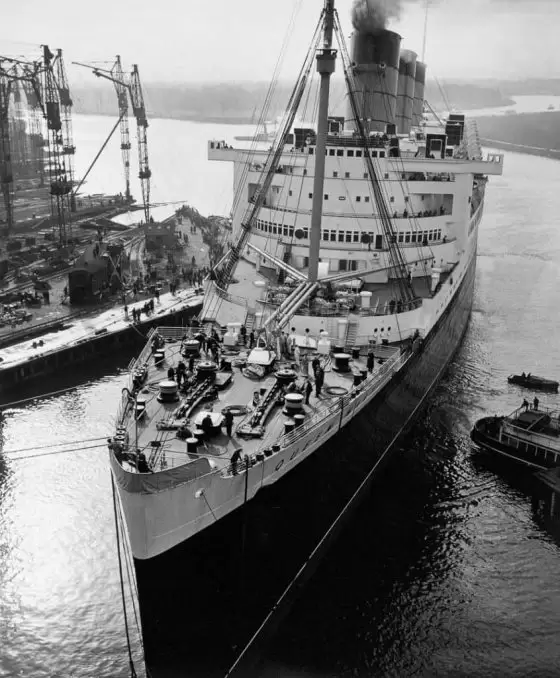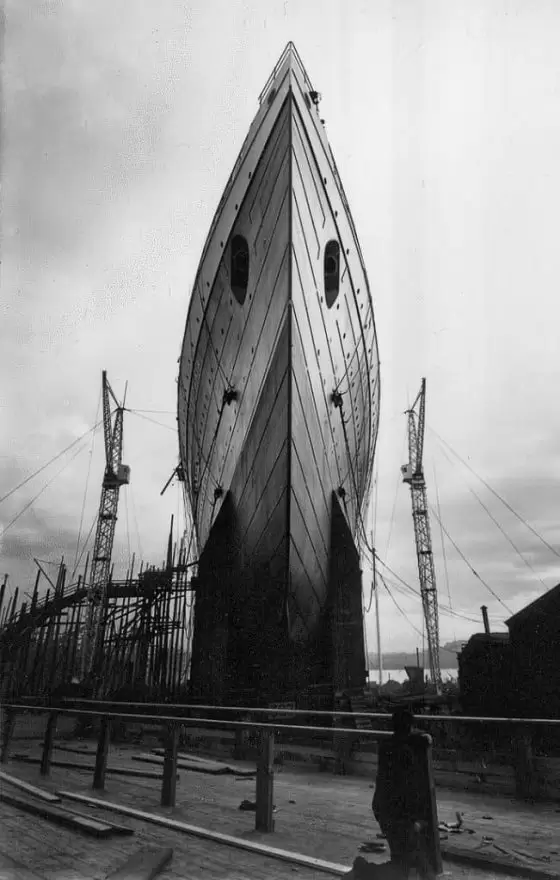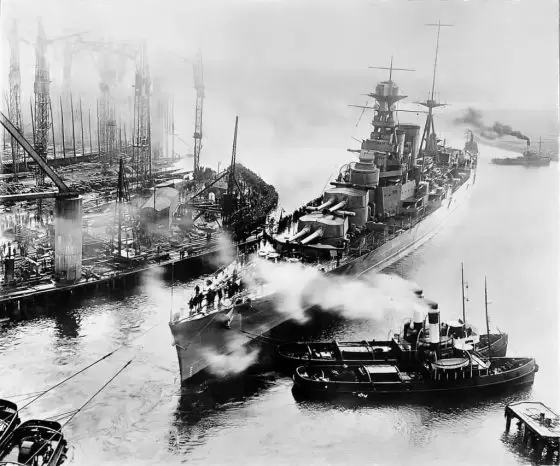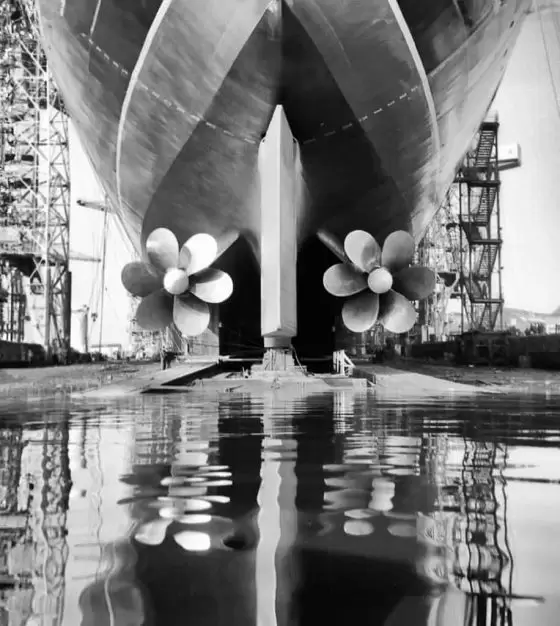Sir John Brown, Naval Architect
Sir John Brown, Naval Architect

Sir John Brown 1901 – 2000
Sir John Brown was born on 6 May 1901 and he died at his home in Broomhill, Glasgow on 27 December 2000, just a few months short of his one hundredth birthday.
Sir John Brown was knighted later in life. Within our family he was always known as “Jack” Brown, or to be more precise “Cousin Jack”.
This photograph shows Jack returning to Heathrow from Sweden having just negotiated a multi-million-pound contract for John Brown’s Shipyard to build a new liner. I have started with this photograph as this shows Jack Brown as I remember him.
I remember him as a very kind man who was always smiling, and always pleased to meet family and friends. At the time that he was managing Director of John Brown & Co Shipyard in Clydebank, he always had time to talk to a young boy like myself, who was full of endless questions about how ships were built. I also recall that when I was a child, he always spoke to me as though I was an adult, rather than a child, and I liked that.
Jack Brown’s Parents
The illustration opposite is a page from the Brown Family Bible showing the birth of Jack’s father, John Brown, on 17 September 1871. Jack’s grandparents were James Brown and Janet Auld. You can read their story here.
Jack’s father, like his grandfather James, was a master lath-splitter. James had established his business as a master lath-splitter in Govanhill, Glasgow and employed several men. The late nineteenth century was a time of rapid expansion in Glasgow and there would have been no shortage of work for those engaged in the building industry. My grandmother was Agnes Auld Brown so Jack Brown and my mother were first cousins.

In his own words
I started at Clydebank as an apprentice in the shipyard drawing office in 1919, and spent several years in the general drawing office. Having graduated from the University of Glasgow in 1923, I was then transferred to the ship design office as a naval architect, and continued there until 1927, when I was seconded to an associate firm in Spain under the direction of a former Clydebank man.
I had two years in Spain as a designer, and as an estimator, coaching Spaniards. I returned to Clydebank where I was appointed Assistant Naval Architect. I served in that capacity from 1929 to 1949, which was a long haul. In 1949, I was made Naval Architect and Technical Manager in charge of the design and drawing office. From 1949 to 1959, I occupied that position, and then I was made Managing Director in succession to Sir James McNeil. I held that position until the end of 1963, when I handed over to John Rannie, with the idea that he would handle the construction of the Queen Elizabeth II.
I had actually supervised the design in conjunction with Cunard, and supervised the tender which was eventually accepted. Since I was approaching retirement age, I was made vice Chairman, with a consultancy role, and stepped out altogether in 1967.
Dr. John Brown, John Brown, Clydebank. (2013). In A. Slaven & H. Murphy (Eds.), Crossing the Bar: An Oral History of the British Shipbuilding, Ship Repairing and Marine Engine Building in the Age of Decline 1956–1990 (Research in Maritime History, pp. 43-46). Liverpool University Press.
RMS Queen Mary
In 1919 Jack started a course in naval architecture at Glasgow University. He had hoped to find employment under the sandwich course scheme, but he found that a downturn in the shipbuilding industry meant that he had to accept a five year apprenticeship instead. He worked under Sir James McNeill at John Brown & Co and in 1923 he graduated with BSc and Distinction in naval architecture. In spite of sharing the same name as his employers, he was no relation.
Before leaving for his secondment to Bilbao, he became engaged to Elizabeth Wright. When he returned from his secondment, he married Elizabeth on 18 April 1930.
Undoubtedly the highlight of Jack’s career was his involvement in the design of the liner RMS Queen Mary for the Cunard Line. It was his first major project with John Brown & Co and the ship came to define his career.
The Queen Mary was launched from Clydebank on 26 September 1934 by Her Majesty Queen Mary. Work on the ship had been stopped because of the Depression and the consequent uncertainty in the shipbuilding business. The launch of the Queen Mary coincided with the heyday of shipbuilding on the Clyde.


John Brown & Co Ltd
John Brown & Co was a steel and armour-plate producer from Sheffield and they acquired the Clydebank business of James and George Thomson in 1890. The Thomson brothers left the business and the fortunes of John Brown & Co prospered as a result of international tensions with Germany. An arms race with Germany ensued, which led to increased demand for new ships.
As well as military competition with Germany, there was intense competition for the trans-atlantic liner trade. By the end of the nineteenth century, Germany enjoyed a dominant position in the translantic liner route holding the prestigious Blue Riband for the fastest crossing. Cunard responded by developing two new liners, the Mauretania and the Lusitania.
The Lusitania was built at John Brown & Co. It was launched into the Clyde on 7 June 1906. I imagine that a young Jack Brown would have been well aware of the launch as it would have been the toast of Glasgow, but as he would only have been five years old, perhaps my imagination is running away with me. Sadly, the ship was sunk off the coast of Ireland by enemy action on 7 May 1915, resulting in the loss of 1,199 passengers and crew. She held the Blue Riband in 1908 and was briefly the world’s largest passenger ship before the launch of her sister ship the Mauretania.
John Brown & Co won their share of miltary orders, building several of the Dreadnought class of Battlecruiser for the Royal Navy, including HMS Barham, Inflexible, Repulse and Tiger.
HMS Hood
Work on the construction of HMS Hood started in John Brown & Company on 1 September 1916 when Hull No 460 was laid down at Clydebank. As a result of the loss of three British battlecruisers at the Battle of Jutland in 1916, 5,000 tons of extra armour and bracing were added to Hood’s design, and she was the only Admiral Class battlecruiser completed.
She was launched on 22 August 1918. I like to imagine that a young Jack Brown, about to embark on his studies to become a naval architect, would have found his way to the banks of the Clyde to watch the launch into the Clyde of “The Mighty Hood”, at the time the world’s largest battlecruiser.


The Empress of Britain 1931
By the late 1920s the outlook for shipbuilding on the Clyde was improving and Canadian Pacific commissioned several luxury liners including Empress of Britain which was launched in 1931.
Jack Brown
Jack’s wife Elizabeth died on 27 November 1953 after 23 years of marriage. He married again on 7 April 1956 to Isabella Munro Gibbon in Crieff. Isobel, as she was known, died on 12 May 1988. My mother always told me that Jack was the only man she knew who had celebrated two silver wedding anniversaries. Whilst not strictly correct, it is near enough.
Jack had lived close to my mother’s house in Muirend, until his wedding in 1930. He established a tradition of being a regular First Footer to the McCann household at Hogmanay.
Many homes across Scotland, honour the tradition of First Footing as the New Year begins. Stemming back to the time of the invading Vikings in the 8th and 9th century, it is believed that the first person to enter a house, the “first foot”, can bring luck, or misfortune, for the year ahead.
In Scottish tradition good luck comes in the form of a tall, dark-haired man being the first footer. On the other hand, women, light-haired men and redheads were seen as harbingers of ill fate. The first footer would traditionally arrive bearing gifts to bring good fortune and health to the home. Gifts generally took the form of a coin, shortbread or something edible, a lump of coal or wood for the fire and a drink of whisky to represent prosperity, food, warmth and good cheer.
Jack continued this tradition throughout his life, visiting my mother’s sister who still lived in Muirend, until he was no longer able to make the journey across Glasgow.


Royal Yacht Britannia
Jack had been in charge of the design team for the two Cunard liners, Queen Mary and Queen Elizabeth, which was launched in 1938. After the liners, Jack was involved in the design and construction of the Royal Yacht Brittania, which launched in 1953.
When the Britannia was de-commisioned, I remember being told that he had been consulted about plans to moor the ship in Leith as a permanent museum. I was told that Jack had suggested that if the ship was no longer able to fulfil her function as a ship, she should be towed out into the Atlantic and scuttled. Apparently, he had tea with Princess Anne when Britannia was on the Clyde on her farewell tour round the British Isles and they both agreed it would be the best solution. He asked to be knighted by her in Glasgow and there were about twenty friends and family present instead of the usual small group.
Cunard Liner Queen Elizabeth 2
Jack had worked most of his career under Sir James McNeill, and when he retired in 1953, Jack took over as Managing Director. Nearing retirement, his final task was to secure the order for the Queen Elizabeth 2 liner. With the order secured he then became Deputy Chairman, handing over the reins to John Rannie in 1963, and finally retiring in 1967.
On 30 December 1964, Cunard placed an order for construction of the new ship with John Brown and Company, who would build it at their shipyard in Clydebank, Scotland. The agreed price was £25,427,000 with provision for escalation of labour and materials increases, with an agreed delivery date of May 1968.
The keel was laid down on 5 July 1965, as hull number 736 on the same slipway where previous Cunard liners such as Lusitania, Aquitania, Queen Mary, and Queen Elizabeth had been constructed.


Queen Elizabeth 2
The ship was launched and named on 20 September 1967 by Queen Elizabeth II, using the same pair of gold scissors her mother and grandmother had used to launch Queen Elizabeth and Queen Mary, respectively. After the bottle of champagne was smashed the QE2 stayed put on the slipway for 90 seconds before being let free.
The name of the liner as it appears on the bow and stern is Queen Elizabeth 2, with upper and lower case lettering and an Arabic numeral 2 as opposed to the Roman numeral II, distinguishing her from the monarch, Elizabeth II. Soon after launching, the name was shortened in common use as QE2.
Queen Elizabeth 2 – 25th Anniversary
Jack visited New York for the 25th anniversary of the maiden voyage of the QE2. He gave a talk without a single note just as he had done in 1993 on a trip to the Queen Mary in Long Beach, California for the 59th anniversary. Maybe they were worried he might not make the 60th the following year, but he managed to live almost another decade.


QE2 Anniversary
Sir John Brown was awarded a knighthood in January 2000. He died at his home in Glasgow on 27 December 2000 at the age of 99.
Acknowledgements
This article has been based on personal recollections and oral tradition within our family. In addition I have used material from the abstract of the Papers of Sir John Brown, ref. UGC 092 at Glasgow University Archive Services, curated by Christine Schmitt-Mackinnon. Other sources include Ian Johnston’s Ships for a Nation – the history of John Brown & Co, Clydebank and the obituary of Sir John Brown in the Glasgow Herald, 30 December 2000.
I am grateful, also, to Jack’s niece Christine Schmitt-Mackinnon for her comments on the first draft of this article and for shared photographs.


